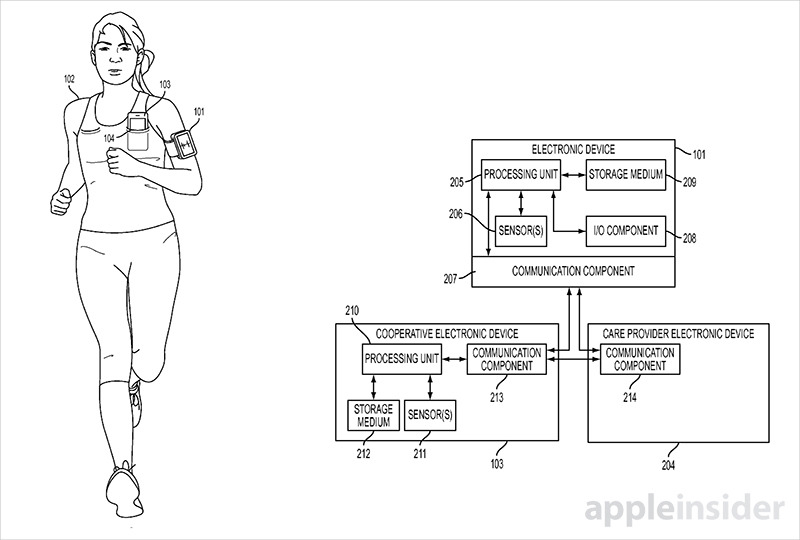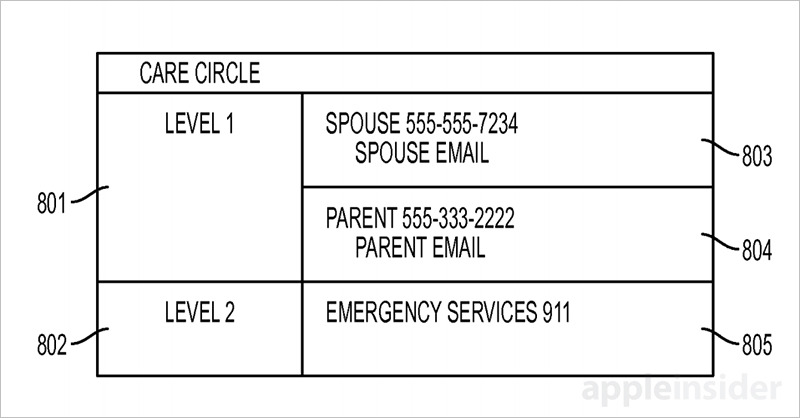A patent application published Thursday suggests Apple is working to turn Apple Watch into a full-fledged medical device, one that can monitor a user's vital signs and automatically send out an alert should they need urgent care.
As published by the U.S. Patent and Trademark Office, Apple's application for "Care event detection and alerts" provides for a hardware system capable of monitoring its surrounding environment for so-called "care events," described as any event that necessitates assistance from medical personnel, police, fire rescue or other emergency technicians. For example, the device could be programmed to monitor a user's heart for an arrhythmia and, upon detection, send out an alert to family or emergency responders.
While not specifically mentioned in the document, Apple Watch is uniquely qualified to fulfill the proposed system's goals. Apple's wearable not only incorporates advanced sensors and processing hardware capable of monitoring for care events, but also packs in a communications suite that can be used to transmit emergency notifications via iPhone.
In operation, the wearable and its host device work together to detect a care event. For example, if an iPhone's accelerometer detects a sudden change in acceleration, while Apple Watch no longer detects a heart rate, the system might determine that a user has had a heart attack and is incapacitated. Other examples include car accidents, muggings and other events that can be quantified by onboard accelerometer, heart rate, microphone, GPS and other sensors.
Once a care event is detected, the system sends out alerts to a predefined list of recipients, dubbed the "care list" or "care circle." Established by the user, or as a phone preset, the care list contains contact information for family members, doctors and general emergency services.
Apple points out that the system needs fine tuning to avoid false alarms. To hedge against system errors, the invention includes a method of triage that escalates notifications based on severity before sending them out to recipients on the care list, itself split into a distinct hierarchy. For example, a user's spouse or family might populate the first level on the care list and will therefore get the initial alert. In some cases emergency services contacts sit at the highest level and are only notified if the situation escalates or all lower level list recipients fail to respond.
Some embodiments call for customized alerts that contain a user's relevant medical records (gathered from the Health app or an offsite database), location and other important information. In some cases users — if lucid — can manually dictate what information is disseminated through onscreen cues.
Apple has yet to position Apple Watch as a bonafide medical device, most likely due to that industry's tight regulations. Indeed, rumors last year claimed the company scrapped plans to integrate advanced health monitoring features into Watch due in part to regulatory hurdles.
While today's patent application is evidence that Apple is continuing work on medical applications for the Apple Watch platform, it remains unclear when such technology will make its way into a shipping product.
Apple's care detection and alert patent application was first filed for in September 2015 and credits Martha E. Hankey and James Foster as its inventors.
 Mikey Campbell
Mikey Campbell








-m.jpg)






 Charles Martin
Charles Martin


 Malcolm Owen
Malcolm Owen
 William Gallagher
William Gallagher
 Christine McKee
Christine McKee
 Marko Zivkovic
Marko Zivkovic
 Mike Wuerthele
Mike Wuerthele









28 Comments
Now, this is what I call a *killer feature*: It is both a Time & Life saver. A must have for the watch.
>:x
EDIT: Coincidentally, this is my *911*'th post.
This is a good idea and a bad idea. I work as an emergency responder and having so many alerts going out at one time can be very challenging To the service, especially when the apple watch isn't accurate. The elderly mainly, has brittle and or tough skin at times where the apple watch will and can inaccurately give false readings. I have a apple watch and it's not always accurate. I hope they can get it right th first time.
In the USA the FDA strongly regulates medical devices. They err on the side of caution and it is very difficult to add new devices or change old ones. I've read plenty of stories where medical device manufacturers run into catch-22 situations where they need to install security updates NOW on the device (running something like Windows XP a few years ago) but can't do it without FDA approval which can take years. Regulations are creating a paralysis by analysis situation. Devices such as the Apple Watch will be useful and potentially life-saving in spite of flaws and inaccuracies.